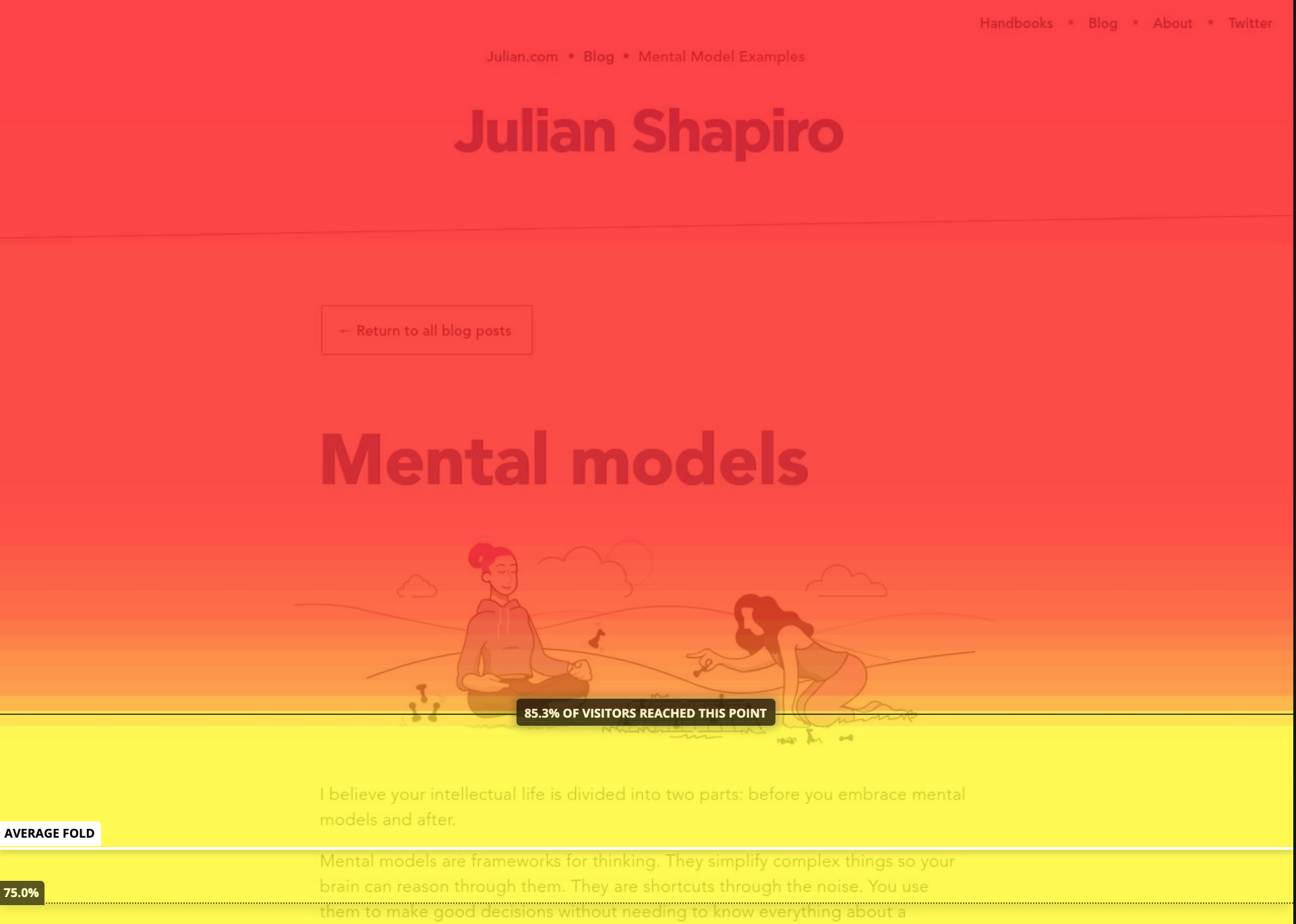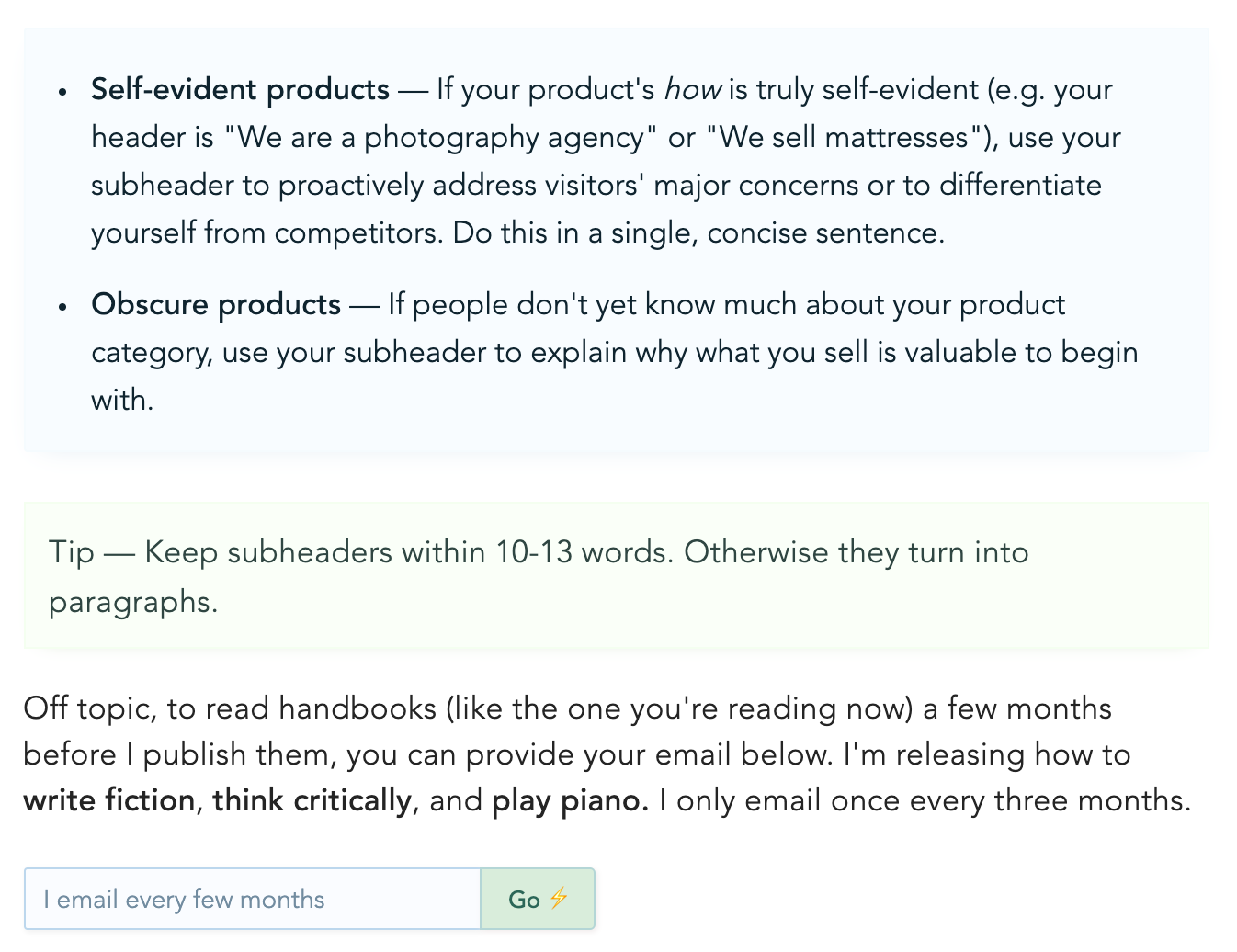Advice on content marketing always talks about getting people to your blog.
But, what about once they’re there — how do you get them to then buy from you?
That’s the conversion half of content marketing, and that’s what I’ll cover: converting your readers into paying customers.
First, they read. Then, they buy.
When visitors arrive on your blog, three things should happen:
- First, they must start reading — instead of bouncing.
- Next, keep should keep reading until at least halfway through.
- Finally, they should be enticed to read more or convert: sign up, subscribe, purchase, etc.
Demand Curve’s data shows that when readers complete this full chain of events — as opposed to skipping step #2 — they’re more likely to ultimately buy from you.
Why? People trust your brand more after they’ve consumed your content and deemed you to be high quality and authoritative.
We’ve optimized tens of millions of blog impressions, and we have three novel insights to share in this post. Each will hopefully help compel readers to stick around and buy.
Let’s conquer high bounce rates — the bane of content marketers.
Entice visitors to start reading
First, some obvious advice: Getting visitors to read begins with having a strong intro.
A good intro buys goodwill with readers so they keep reading — and tolerate your boring parts.
There are three components to a good intro:
- Have a hook. Read about hooks here.
- Skip self-evident fluff. Read about succinctness here.
- Tease your subtopics to reassure visitors they landed in the right place.
The web’s biggest blogs include tables of contents at the top of their posts to reassure readers. It not only benefits SEO, it also improves read-through rates.
Keep them reading once they’ve started
Once visitors begin reading, you have three tactics to retain them:
- Drop-off optimization.
- A/B testing.
- Exit rate analysis.
This is how we’ll improve our read-through and conversion rates.
Drop-off optimization
Sometimes, when I write a post on Julian.com, I find few people actually finish reading it. They get halfway through then bounce.
I discover this by looking at my scroll-depth maps using Hotjar.com. These show me how far down a page an average reader gets. Then I pair that data with the average time spent on the page, which I get from Google Analytics.
Whenever I notice poor read completion rates, I spend ten minutes optimizing my content:
- I refer to the heatmaps to see which sections caused people to stop reading.
- Then I rewrite those offending sections to be more enticing.
This routinely achieves 1.5-2x boosts in read-through rates, which can lead to a similar boost in conversion.
You see, I never just publish a blog post then move on.
I treat my posts the same way I treat every other marketing asset: I measure and iterate.
For some reason, even professional content marketers publish their posts then simply move on. That’s crazy. Not spending 10 minutes optimizing can be the difference between people devouring your post or not being able to get halfway through.
Specifically, here’s the process for rewriting a post’s drop-off points to get readers to continue reading.
How to perform drop-off optimization
First, record a scroll heatmap of your blog post. Any heatmap tool will do. I use Hotjar.com.
Next, whenever you see, say, 80% of readers getting midway into your post but only a fraction then make it to the end, you know you have a problem in the back half of your post: it’s verbose, uninsightful, or off-topic.
Your job is to find these drop-off points then rewrite the offending content using four techniques:
- Brevity: Make the section more concise: Cut the filler and switch to a bullet list like the one you’re reading now. Or, delete the section altogether if it’s not interesting.
- Inject insights: Perhaps your content is self-evident and boring. Rewrite it with novel and surprising thoughts.
- Make headlines enticing: Make the next section’s headline more enticing. Perhaps readers bounce because they see that the next section’s title is boring or irrelevant. For example, instead of titling your next section “Wrapping up,” re-write it into something more eyebrow-raising like, “What you still don’t know.”
- Cliffhangers: End sections with a statement like “Everything I just told you is true, but there’s a big exception.” Then withhold the exception until the next section. Keep them reading.
Once you’ve ironed out drop-off points, perhaps 35% of your readers finish the post instead of 15%. This reliably works, and it’s the highest-leverage way to achieve conversion improvements on your posts.
This is so self-evident yet no one does it for some reason.
And we’re only just starting. There’s another, more effective technique for optimizing your content: A/B testing paragraphs. Whereas drop-off optimization irons out the kinks in your article, A/B testing is how you take your read-through rates to a new tier.
Before we begin, follow along
As we explore the tactics below, you’re welcome to visit two blogs that incorporate these techniques:
If you need a primer on SEO before continuing, see my other TechCrunch article on the topic here and this orientation here.
A/B testing content
A/B testing is the process of creating a variation of existing content to see if it will increase conversion.
You want to A/B test the three highest-leverage components of every post:
- Your title: Write titles that match what visitors are searching for and entices them. Don’t be cute; be clear and self-evident.
- Your intro: Write an introduction that frames your post in a different way.
- Your call to action (CTA): Redesign your signup/purchase prompts with different copy, value propositions, and aesthetics.
This takes less than 30 minutes and can often double conversion rates.
On Julian.com, for example, I A/B tested my newsletter CTA, and was able to significantly increase my signup rates: I discovered that a subtle CTA inlined between paragraphs outperformed a full-width CTA that cut the page in half to ask for your email.
Here’s the winning A/B variant — see the email prompt at the bottom:
A/B testing isn’t optional
High-traffic posts should have an A/B test running all the time. Traffic you’re acquiring that isn’t being tested against is a wasted opportunity to acquire data on what might significantly improve your conversion.
I use Google Optimize to run A/B tests. It’s free and it integrates into Google Analytics.
Exit rate analysis
I’ve saved the best for last.
Exit rate analysis is how you compel readers to consume more of your content — beyond the post they landed on.
Because, again, enticing readers further down the rabbit hole of your content increases their trust in you, their ability to remember you, and typically their desire to buy from you.
Performing exit rate analysis
First, open up your Google Analytics to find which blog posts have the highest exit rates. A page’s “exit rate” is the percentage of visits to that page resulting in the visitor immediately leaving the site.
This is different than bounce rate, which is a measure of which pages visitors initially landed on that they immediately left from.
Exit rates, in contrast, assess the last page a user saw — regardless of whether it was the first page they landed on.
Here’s why exit rates matter: Your lowest exit rate posts are the ones that are so good that people want to read more of your content afterward.
That’s what we call your hero content.
Find your hero content using Google Analytics then consistently recommend these pieces at the bottom of every blog post. Stop blindly recommending “related posts.” Instead, funnel readers to the content you statistically know is likely to hook them and carry them down the rabbit hole.
How do you then get them to buy?
By this point, your readers are reading your content.
Now it’s time to get them to buy.
There are two principles to focus on here.
Principle 1: Naturally segue to your pitch
Avoid pitching your product until the back half of your post. Pitching in the first half undercuts the authenticity of your advice — by making you come off like a salesperson.
Plus, the first half helps establish that you’re an authority on your topic. The further someone gets into an authoritative article, the more familiarity and trust they accrue for your brand. Again, get them to trust you before you pitch them.
Principle 2: Don’t make your pitch look like an ad
Make your pitch look like a natural extension of your article.
As mentioned, many sites make the mistake of making CTA’s look like big, show-stopping banners. Readers reflexively dismiss these callouts as ads.
Instead, consider plugging your product using a normal text link — styled no differently than any other link in your post. Keep it natural, and segue organically.
What you need to do next
The lesson here is to never publish a blog post then just walk away. Your work isn’t done. You need to optimize:
- Reduce drop-offs points.
- A/B test better introductions and CTA’s.



